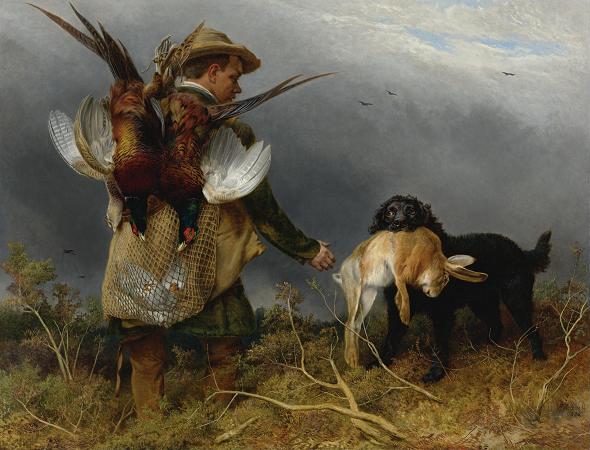Edwin Landseer (1796 - 1871). Sir Edwin Henry Landseer was an English painter and sculptor, well known for his paintings of animals-particularly horses, dogs, and stags. However, his best known works are the lion sculptures in Trafalgar Square. Landseer was born in London, the son of the engraver John Landseer A.R.A. He was something of a prodigy whose artistic talents were recognised early on. He studied under several artists, including his father, and the history painter Benjamin Robert Haydon, who encouraged the young Landseer to perform dissections in order to fully understand animal musculature and skeletal structure. Landseer's life was entwined with the Royal Academy. At the age of just 13, in 1815, he exhibited works there. He was elected an Associate at the age of 24, and an Academician five years later in 1831. In 1823 Landseer was commissioned to paint a portrait of Georgiana Russell, Duchess of Bedford. Despite her being twenty years older than he was, they began an affair. He was knighted in 1850, and although elected to be president of the Royal Academy in 1866 he declined the invitation. In his late thirties Landseer suffered what is now believed to be a substantial nervous breakdown, and for the rest of his life was troubled by recurring bouts of melancholy, hypochondria, and depression, often aggravated by alcohol and drug use. In the last few years of his life Landseer's mental stability was problematic, and at the request of his family he was declared insane in July 1872. Landseer was a notable figure in 19th-century British art, and his works can be found in Tate Britain, the Victoria and Albert Museum, Kenwood House and the Wallace Collection in London. He also collaborated with fellow painter Frederick Richard Lee. Landseer's popularity in Victorian Britain was considerable, and his reputation as an animal painter was unrivalled. Much of his fame-and his income-was generated by the publication of engravings of his work, many of them by his brother Thomas. One of his earliest paintings is credited as the origin of the myth that St. Bernard rescue dogs in the Alps carry a small casket of brandy on their collars. Alpine Mastiffs Reanimating a Distressed Traveller shows two of the dogs standing over a man who is partially buried in snow. One is barking to attract attention while the other, who is depicted with the miniature barrel, attempts to revive the man by licking his hand. His appeal crossed class boundaries: reproductions of his works were common in middle-class homes, while he was also popular with the aristocracy. Queen Victoria commissioned numerous pictures from the artist. Initially asked to paint various royal pets, he then moved on to portraits of ghillies and gamekeepers. Then, in the year before her marriage, the queen commissioned a portrait of herself, as a present for Prince Albert. He taught both Victoria and Albert to etch, and made portraits of Victoria's children as babies, usually in the company of a dog. He also made two portraits of Victoria and Albert dressed for costume balls, at which he was a guest himself. One of his last paintings was a life-size equestrian portrait of the Queen, shown at the Royal Academy in 1873, made from earlier sketches. Landseer was particularly associated with Scotland, which he had first visited in 1824 and the Highlands in particular, which provided the subjects for many of his important paintings. The paintings included his early successes The Hunting of Chevy Chase, An Illicit Whisky Still in the Highlands and his more mature achievements, such as the majestic stag study The Monarch of the Glen and Rent Day in the Wilderness. In 1828, he was commissioned to produce illustrations for the Waverley Edition of Sir Walter Scott's novels. So popular and influential were Landseer's paintings of dogs in the service of humanity that the name Landseer came to be the official name for the variety of Newfoundland dog that, rather than being black or mostly black, features a mix of both black and white. It was this variety Landseer popularised in his paintings celebrating Newfoundlands as water rescue dogs, most notably Off to the Rescue, A Distinguished Member of the Humane Society, and Saved. The paintings combine the Victorian conception of childhood with the appealing idea of noble animals devoted to humankind, a devotion indicated, in Saved, by the fact the dog has rescued the child without any apparent human involvement. Landseer's painting Laying Down The Law satirises the legal profession through anthropomorphism. It shows a group of dogs, with a poodle symbolising the Lord Chancellor. The Shrew Tamed was entered at the 1861 Royal Academy Exhibition and caused controversy because of its subject matter.
more...














